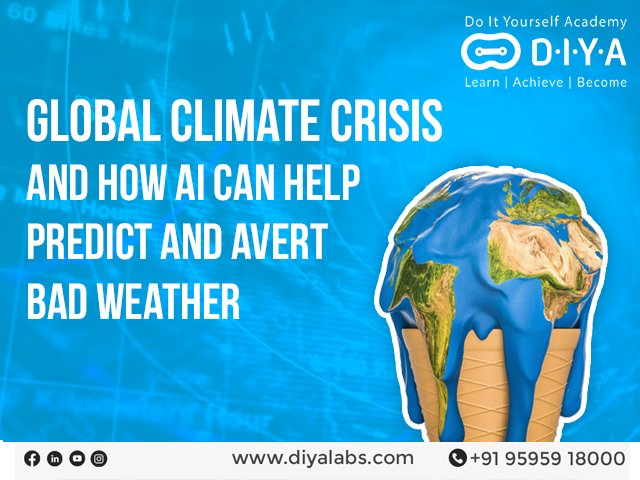Global climate crisis

Every environmentalist is talking about the global climate crisis. What is it? In short, increasing pollution, emission of greenhouse gasses, and landfills (land area filled with garbage) are causing a change in the global temperature. The rise in temperature will lead to disasters such as droughts, fires, floods, storms, and irregular rain patterns. News from various parts of the world, over the last few years have shown us that all this is happening right now. The fires in the Amazon rainforest in 2019, wildfires in Australia from 2019 to 2020, and the massive floods across Europe in 2021 are huge indicators that the global climate crisis is a current problem and not something that we could expect in the future.
Environmentalists and the United Nations are lobbying for adopting eco-friendly practices to reduce the effect of the global climate crisis. Technologists are looking toward Artificial Intelligence (AI) to discover methods to use algorithms and geoengineering to predict and avert bad weather. A few of the ways we believe that AI can help avert global climate crisis are:
Accelerate response time and reduce greenhouse gas emissions
It’s estimated that AI can help industries produce consumer products and automotive products that will help reduce greenhouse gas emission by nearly 16%. A major transformation is the adoption of electric vehicles and the gradual replacement of petrol and diesel fueled vehicles. Petrol and diesel release large amounts of carbon dioxide and heat, which directly increase the global temperature.
A related application of AI is to predict the demand and supply of the electricity required for powering the electric vehicles. Proper prediction can be used to ensure seamless distribution of electric power, so there are no hassles in powering and running electric-powered vehicles.
Design Smart Cities
The concept of smart cities has been gaining traction over the last decade. These cities are designed and monitored using artificial intelligence technologies. The aim of smart cities is to create a living environment that’s pollution free and sustainable.
Predict wind patterns
Wind patterns are closely associated with droughts, storms and cyclones. Artificial intelligence algorithms are designed to predict wind patterns at least 36 hours in advance. There are multifold benefits of such predictions. One, wind farms can make optimum use of the increase in wind speeds to generate more energy. Secondly, the predictions can be used to prevent or at least reduce to a great extent the damage caused by the change in the wind conditions.
Identify and understand carbon footprints
If we need to reduce the carbon footprints, we need to identify where they’re the highest and what conditions or actions increase the carbon footprints. We can create AI algorithms that will help track and trace the origin and travel of the footprints.
Build low-carbon materials
From polythene covers and plastic items to vehicle fuels, most materials that we use in daily life contain carbon. When these materials are burnt, they release carbon dioxide, a greenhouse gas that increases global temperature. AI technology can be used to identify and create materials that are not carbon-based, but have similar properties and functionalities.
Monitor deforestation and agricultural practices
Global warming is not caused only because of burning of fuels, but also because of deforestation and unsustainable agricultural practices. Cutting down forests and burning them doubly damages the environment. First, burning releases massive volumes of greenhouse gasses. Secondly, we are destroying the lungs of the Earth, which help maintain the fragile balance of good and bad gasses. AI solutions can be used to exactly pinpoint regions where oxygen-rich areas are turning into carbon pits.
Geoengineer the earth
It’s an extreme idea that is still in the speculation stage. It involves designing artificial clouds that reflect most of the heat from the sun back into space. So, the global temperature can be reduced by a few degrees. However, it’s still in the idea stage and we don’t know what complications could occur by setting up such artificial clouds.
Conclusion
Global climate crisis is a hard reality that we need to face and overcome in order to leave a better world for the children. Artificial intelligence tools and technologies can be used to address the climate crisis and reduce its damaging effects to a great extent. All of this is possible with advanced computing power that makes use of artificial intelligence and its related algorithms. Would you like to know how to develop such AI algorithms that can save the balance of the precious ecosystems? It all starts with the small step in addressing the challenges and understanding them better. Contact us today at DIYA Labs and learn the basics of AI from the courses we have to offer. Create your own solutions to global problems and reach out to make a better world for tomorrow!